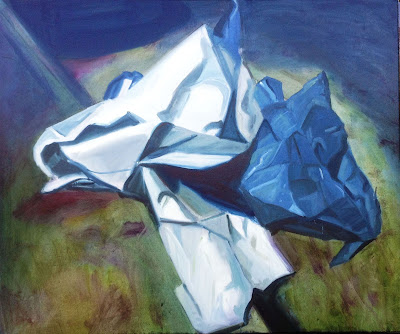Julian Schnabel, 'Ornamental Despair (Painting for Ian Curtis)', oil on velvet, 1980
I visited ‘True
Faith’ at Manchester City Art gallery the other week with my friend, artist and
writer Andrew Smith. It was an exhibition celebrating the influence the music
of Joy Division and New Order have had on a range contemporary artists, and as
such was a diverse show of painting, sculpture, artist films, photography,
printmaking and graphics. It included artworks by many art world ‘big
hitters’, including Julian Schnabel, Martin Boyce, Dexter Dalwood, Liam
Gillick, Glenn Brown and Mark Lecky amongst others. It also featured a
collection of memorabilia from both bands in the form of hand-written lyrics by Curtis, notebooks and graphic artwork such as posters,
record sleeves and flyers, with many of the later ones designed by artists as
diverse as John Baldessari, Barbara
Kruger and Robert Longo. And of course heavily
represented was the influential artwork of graphic designer Peter Saville which
has been a mainstay with the band right up until their current incarnation.
Barbara Kruger's poster for New Order's 'The Perfect Kiss'
Peter Saville's design for 'Power Corruption and Lies', using a painting, or a postcard of a painting by nineteenth century painter Henri Fantin Latour
His
innovative graphic work set the template early on for so many of both band’s
defining aesthetic ideas in the way they presented themselves and their music,
which is sort of what many of the artworks in the show also seem to respond to
and reflect. I thought it was a shame that Anton Corbijn’s famous black and
white photographs of Joy Division in various evocative 70’s urban locations
around Salford, Manchester and London were not present. I would have thought these had
been highly influential on much rock photography that has since followed, and
also very much defined the identity of the band. They are the images I think of
when Joy Division come to mind.
A selection of Anton Corbjin's photographs of Joy Division in 1980, not represented in the show
There is a
good write up here:
about the
context and ideas behind much of the work on display, but for my own purposes I
thought I would reflect on a few specific pieces that I particularly enjoyed
and really got me thinking about some of my own ideas and work.
Mark Leckey, 'Dream English Kid 1964-1999AD', video still
Unusually
for me the work that left the biggest impression on me was a film by artist
Mark Leckey called ‘Dream English Kid 1964-1999 AD’, seen here: https://vimeo.com/144790614
This 23
minute autobiographical film had me totally absorbed with its found footage of
post-war leading to post-industrial Britain, particularly Leckey's native Liverpool, from the 1960’s to the 1990’s; a
world of empty nocturnal motorways (sound familiar?), towering pylons linked
across the landscape, council estates, factories and nightclubs, and excerpts
from long forgotten TV shows. This was combined with footage the artist himself
had filmed, which included in particular scenes from underneath a model he had
made of a motorway bridge. In this video link here: https://www.youtube.com/watch?v=AspgWgMBJ1s
Lecky discusses the piece
underneath a life size version of this model installed in a gallery.
Mark Leckey, installation shot 'Containers and Their Drivers' 2016
The film
obviously brought to mind my own paintings beneath motorway bridges at night, and
reminded me how connected I felt to the world depicted in Lecky’s film. I’m
currently working on some other things in my painting, which I would like to
discuss at some point when they are a bit more resolved, but this film felt like
a strong calling to this shadowy nocturnal world of concrete and steel and all
those bits of landscape between: the edge lands.
Shaun Morris, 'Silence', oil on canvas, 100 x 120cms, 2012
I also loved the sculptures of Martin Boyce,
which were installed around much of the low-lit, gallery and how they were
described as representing ‘the experience of walking through the park late at
night’. They hover between abstraction and figuration (again, sound familiar?)
with a strong leaning towards early modernism, and are made from and reference the
materials and forms one might find in the landscaping and architecture of the
city, including cast metal, wire mesh, fluorescent lighting, bins and containers.
Martin Boyce, 'Our Love is like the Flowers, the Rain, The Sea, The Hours' (title references lyrics from a Joy Division song)
Shaun Morris, 'The Street (Negativland), oil on canvas, 100 x 120cms, 2017
Often
objects were spotlighted as if seemingly under sodium streetlamps, which seemed
to echo some of the images of my recent ‘Negativland’ paintings. I found the
whole experience really inspiring, and it offered me a much needed sense of renewal
with some of my own ideas at this time. I left the exhibition with an urgency
to push on…
Here’s a link
to a great review by The Guardian’s Adrian Searle: https://www.theguardian.com/artanddesign/2017/jul/04/true-faith-review-the-exhilarating-art-and-afterlife-of-joy-division-and-new-order
‘True Faith’
is on at Manchester City Art gallery until September 3rd and is part
of the Manchester International Festival .













No comments:
Post a Comment